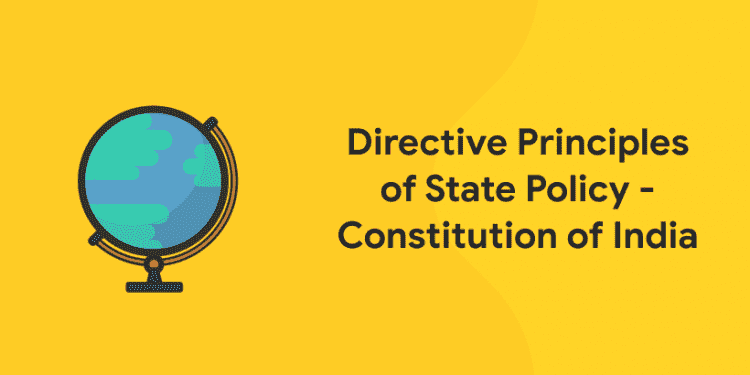Table of Contents
Articles 36-51 under Part-IV of Indian Constitution deal with Directive Principles of State Policy (DPSP). They are borrowed from the Constitution of Ireland, which had copied it from the Spanish Constitution. This article will solely discuss the Directive Principles of State Policy, its importance in the Indian Constitution and the history of its conflict with Fundamental Rights. This topic is important for UPSC Mains GS-II and also for political science optional papers and aspirants can also download the DPSP notes. In this blog we will discuss about Directive Principles of State Policy.
Attempt free GK Mock Test! Download Entri App!
What are the Directive Principles of State Policy?
The Sapru Committee in 1945 suggested two categories of individual rights. One being justiciable and the other being non-justiciable rights. The justiciable rights, as we know, are the Fundamental rights, whereas the non-justiciable ones are the Directive Principles of State Policy.
DPSP are ideals which are meant to be kept in mind by the state when it formulates policies and enacts laws. There are various definitions to Directive Principles of State which are given below:
- They are an ‘instrument of instructions’ which are enumerated in the Government of India Act, 1935.
- They seek to establish economic and social democracy in the country.
- DPSPs are ideals which are not legally enforceable by the courts for their violation.
Directive Principles of State Policy – Classification
1: Who was the first woman President of India?
Indian Constitution has not originally classified DPSPs but on the basis of their content and direction, they are usually classified into three types-
- Socialistic Principles,
- Gandhian Principles and,
- Liberal-Intellectual Principles.
The details of the three types of DPSPs are given below:
| DPSP – Socialistic Principles | |
| Definition: They are the principles that aim at providing social and economic justice and set the path towards the welfare state. Under various articles, they direct the state to: | |
| Article 38 | Promote the welfare of the people by securing a social order through justice—social, economic and political—and to minimise inequalities in income, status, facilities and opportunities |
| Article 39 | Secure citizens:
|
| Article 39A | Promote equal justice and free legal aid to the poor |
| Article 41 | In cases of unemployment, old age, sickness and disablement, secure citizens:
|
| Article 42 | Make provision for just and humane conditions of work and maternity relief |
| Article 43 | Secure a living wage, a decent standard of living and social and cultural opportunities for all workers |
| Article 43A | Take steps to secure the participation of workers in the management of industries |
| Article 47 | Raise the level of nutrition and the standard of living of people and to improve public health |
| DPSP – Gandhian Principles | |
| Definition: These principles are based on Gandhian ideology used to represent the programme of reconstruction enunciated by Gandhi during the national movement. Under various articles, they direct the state to: | |
| Article 40 | Organise village panchayats and endow them with necessary powers and authority to enable them to function as units of self-government |
| Article 43 | Promote cottage industries on an individual or co-operation basis in rural areas |
| Article 43B | Promote voluntary formation, autonomous functioning, democratic control and professional management of co-operative societies |
| Article 46 | Promote the educational and economic interests of SCs, STs, and other weaker sections of the society and to protect them from social injustice and exploitation |
| Article 47 | Prohibit the consumption of intoxicating drinks and drugs which are injurious to health |
| Article 48 | Prohibit the slaughter of cows, calves and other milch and draught cattle and to improve their breeds |
| DPSP – Liberal-Intellectual Principles | |
| Definition: These principles reflect the ideology of liberalism. Under various articles, they direct the state to: | |
| Article 44 | Secure for all citizens a uniform civil code throughout the country |
| Article 45 | Provide early childhood care and education for all children until they complete the age of six years |
| Article 48 | Organise agriculture and animal husbandry on modern and scientific lines |
| Article 49 | Protect monuments, places and objects of artistic or historic interest which are declared to be of national importance |
| Article 50 | Separate the judiciary from the executive in the public services of the State |
| Article 51 |
|
Free UPSKILLING Courses!
Take your first step toward mastering in-demand skills, acing interviews, and securing top-tier jobs with Entri's free upskilling courses.
Start Learning!What are the new DPSPs added by the 42nd Amendment Act, 1976?
42nd Amendment Act, 1976 added four new Directive Principles in the list:
| S.No | Article | New DPSPs |
| 1 | Article 39 | To secure opportunities for the healthy development of children |
| 2 | Article 39A | To promote equal justice and to provide free legal aid to the poor |
| 3 | Article 43A | To take steps to secure the participation of workers in the management of industries |
| 4 | Article 48A | To protect and improve the environment and to safeguard forests and wildlife |
Facts about Directive Principles of State Policy:
- A new DPSP under Article 38 was added by the 44th Amendment Act of 1978, which requires the State to minimise inequalities in income, status, facilities and opportunities.
- The 86th Amendment Act of 2002 changed the subject-matter of Article 45 and made elementary education a fundamental right under Article 21A. The amended directive requires the State to provide early childhood care and education for all children until they complete the age of six years.
- A new DPSP under Article 43B was added by the 97th Amendment Act of 2011 relating to co-operative societies. It requires the state to promote voluntary formation, autonomous functioning, democratic control and professional management of co-operative societies.
- The Indian Constitution under Article 37 makes it clear that ‘DPSPs are fundamental in the governance of the country and it shall be the duty of the state to apply these principles in making laws.’
Criticism of Directive Principles of State Policy
As a point of debate, the following reasons are stated for the criticism of Directive Principles of State Policy:
- It has no legal force
- It is illogically arranged
- It is conservative in nature
- It may produce constitutional conflict between centre and state
What is the conflict between Fundamental Rights and DPSPs?
With the help of four court cases given below, candidates can understand the relationship between Fundamental Rights and Directive Principles of State Policy:
Champakam Dorairajan Case (1951)
Supreme Court ruled that in any case of conflict between Fundamental Rights and DPSPs, the provisions of the former would prevail. DPSPs were regarded to run as a subsidiary to Fundamental Rights. SC also ruled that Parliament can amend Fundamental Rights through constitutional amendment act to implement DPSPs.
Result: Parliament made the First Amendment Act (1951), the Fourth Amendment Act (1955) and the Seventeenth Amendment Act (1964) to implement some of the Directives.
Golaknath Case (1967)
Supreme Court ruled that Parliament cannot amend Fundamental Rights to implement Directive Principles of State Policy.
Result: Parliament enacted the 24th Amendment Act 1971 & 25th Amendment Act 1971 declaring that it has the power to abridge or take away any of the Fundamental Rights by enacting Constitutional Amendment Acts. 25th Amendment Act inserted a new Article 31C containing two provisions:
-
- No law which seeks to implement the socialistic Directive Principles specified in Article 39 (b)22 and (c)23 shall be void on the ground of contravention of the Fundamental Rights conferred by Article 14 (equality before law and equal protection of laws), Article 19 (protection of six rights in respect of speech, assembly, movement, etc) or Article 31 (right to property).
- No law containing a declaration for giving effect to such policy shall be questioned in any court on the ground that it does not give effect to such a policy.
Kesavananda Bharti Case (1973)
Supreme Court ruled out the second provision of Article 31C added by the 25th Amendment Act during Golaknath Case of 1967. It termed the provision ‘unconstitutional.’ However, it held the first provision of Article 31C constitutional and valid.
Result: Through the 42nd amendment act, Parliament extended the scope of the first provision of Article 31C. It accorded the position of legal primacy and supremacy to the Directive Principles over the Fundamental Rights conferred by Articles 14, 19 and 31.
Minerva Mills Case (1980)
Supreme Court held the extension of Article 31C made by the 42nd amendment act unconstitutional and invalid. It made DPSP subordinate to Fundamental Rights. Supreme Court also held that ‘the Indian Constitution is founded on the bedrock of the balance between the Fundamental Rights and the Directive Principles.’
Supreme Court’s rulings following the case were:
- Fundamental Rights and DPSPs constitute the core of the commitment to social revolution.
- The harmony and balance between Fundamental Rights and Directive Principles of State Policy is an essential feature of the basic structure of the Constitution.
- The goals set out by the Directive Principles have to be achieved without the abrogation of the means provided by the Fundamental Rights.
Conclusion: Today, Fundamental Rights enjoy supremacy over the Directive Principles. Yet, Directive Principles can be implemented. The Parliament can amend the Fundamental Rights for implementing the Directive Principles, so long as the amendment does not damage or destroy the basic structure of the Constitution
Ace your Preparation for Competitive Exams! Download Entri App!
Why Practice from Entri?
- Always provides you up to date materials that are created by Entri’s Top Experts.
- Mock tests available in bilingual and other regional languages
- Download Entri to access the unlimited mock test.
Navigating through Entri
- Open your Entri App go to the Bank Tab and check the mock tests.
- You can check courses and Mock test for other examinations as well
- Subscribe to our Mock Test and clear your examination with flying colors.
We hope this blog on SSC JE Civil Engineering Questions and Answers has given you an idea of the level of questions asked in exam. Ace your preparation. That is where Entri comes in. It helps you to prepare effectively for your Exam.









